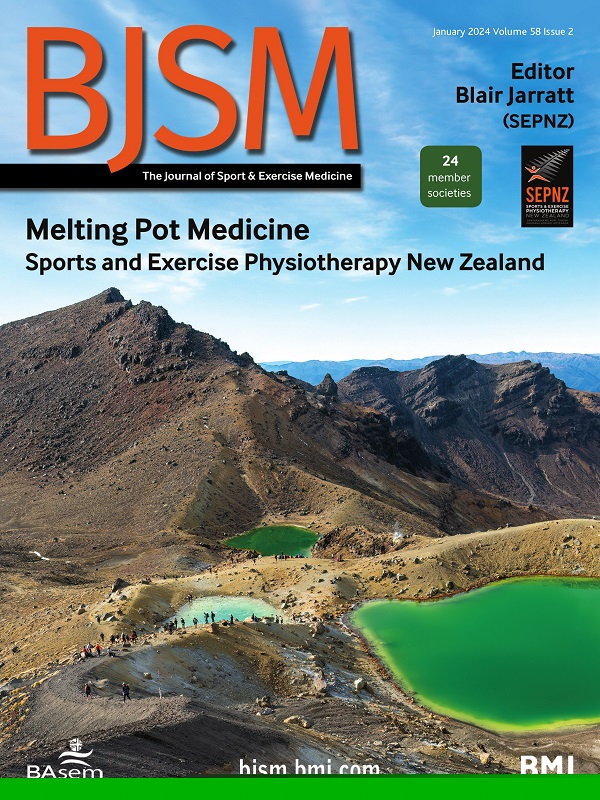Is 9 months the sweet spot for male athletes to return to sport after anterior cruciate ligament reconstruction?
IF 11.6
1区 医学
Q1 SPORT SCIENCES
引用次数: 0
Abstract
Objective Most studies examining the time to return to sport (RTS) after anterior cruciate ligament reconstruction (ACLR) do not account for the athlete’s physical readiness. This study aimed to investigate the status of male athletes at 2 years after ACLR, the factors affecting a return to pivoting sports, and the association between time to RTS and subsequent knee injury risk for those athletes who met discharge criteria. Methods We prospectively followed 530 male athletes (mean age 26.7±7.7 years) participating in pivoting sports throughout rehabilitation and at 2 years after ACLR. Pair-wise analyses were conducted to compare athletes who returned to pivoting sports and those who did not. We performed a Cox regression analysis to assess the association between subsequent non-contact or indirect contact knee injuries and time to RTS. Pearson’s χ2 test was used to compare athletes who RTS in ≤9 months to those who RTS in >9 months after ACLR. Results In total, 379 (72%) athletes returned to pivoting sports at 2 years after ACLR. Athletes who completed rehabilitation and met discharge criteria (n=190) were almost 6 times more likely to return to their preinjury sport (OR 5.71; 95% CI 3.39 to 9.62). Of those who did not complete their rehabilitation (n=340), 132 (39%) did not return to pivoting sports. For athletes who met discharge criteria, time to RTS was not associated with the risk of new knee or ACL injury. There was no increased risk for new knee (HR 0.892, 95% CI 0.39 to 2.07, p=0.79) or ACL (HR 0.718, 95% CI 0.24 to 2.17, p=0.56) injury whether athletes returned before or after the 9-month mark following ACLR. Conclusions Completing rehabilitation and meeting objective criteria significantly increased the odds for male athletes to return to pivoting sports. Time to RTS did not impact the risk for a new knee or ACL injury if athletes met objective criteria. Data are available on reasonable request.9个月是男运动员前交叉韧带重建后恢复运动的最佳时间点吗?
目的大多数检查前交叉韧带重建(ACLR)后恢复运动时间(RTS)的研究没有考虑运动员的身体准备情况。本研究旨在调查男性运动员在ACLR后2年的状态,影响他们重返旋转运动的因素,以及那些符合退役标准的运动员重返旋转运动时间与随后膝盖损伤风险之间的关系。方法对530名男性运动员(平均年龄26.7±7.7岁)进行前瞻性随访,随访时间为康复期间和ACLR术后2年。研究人员进行了成对分析,比较了重返旋转运动的运动员和没有重返旋转运动的运动员。我们进行了Cox回归分析,以评估随后的非接触性或间接接触性膝关节损伤与RTS时间之间的关系。采用Pearson χ2检验比较ACLR术后≤9个月发生RTS的运动员与50 ~ 9个月发生RTS的运动员。结果在ACLR术后2年,共有379名(72%)运动员恢复了旋转运动。完成康复并符合出院标准的运动员(n=190)恢复损伤前运动的可能性几乎是其6倍(OR 5.71;95% CI 3.39 ~ 9.62)。在未完成康复的患者中(n=340), 132例(39%)没有重返旋转运动。对于符合出院标准的运动员,进行RTS的时间与新膝关节或前交叉韧带损伤的风险无关。无论运动员在ACLR术后9个月之前还是之后返回,新膝关节(HR 0.892, 95% CI 0.39 ~ 2.07, p=0.79)或ACL (HR 0.718, 95% CI 0.24 ~ 2.17, p=0.56)损伤的风险均未增加。结论完成康复并达到客观标准可显著提高男性运动员重返旋转运动的几率。如果运动员符合客观标准,接受RTS的时间不会影响新膝关节或前交叉韧带损伤的风险。如有合理要求,可提供资料。
本文章由计算机程序翻译,如有差异,请以英文原文为准。
求助全文
约1分钟内获得全文
求助全文
来源期刊
CiteScore
27.10
自引率
4.90%
发文量
217
审稿时长
3-8 weeks
期刊介绍:
The British Journal of Sports Medicine (BJSM) is a dynamic platform that presents groundbreaking research, thought-provoking reviews, and meaningful discussions on sport and exercise medicine. Our focus encompasses various clinically-relevant aspects such as physiotherapy, physical therapy, and rehabilitation. With an aim to foster innovation, education, and knowledge translation, we strive to bridge the gap between research and practical implementation in the field. Our multi-media approach, including web, print, video, and audio resources, along with our active presence on social media, connects a global community of healthcare professionals dedicated to treating active individuals.

 求助内容:
求助内容: 应助结果提醒方式:
应助结果提醒方式:


